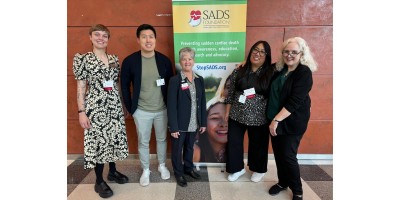A Hong Kong mother is spearheading a campaign to increase public awareness of the silent heart condition known as SADS, which took her son’s life, writes Hazel Knowles.
It was on the night of June 25, 2012, that Shirley Chan Chow kissed her son Dwayne goodnight and told him she loved him. It was the last time she saw him alive.
Dwayne was a 31-year-old New York University graduate and an ambitious businessman with a wide circle of friends. He loved to sail, ski, dive, hike and take photographs. He had his own apartment but on that particular night he came home to spend time with his parents.
“He was going on holiday with his sister and his friends in two days and was happy and cheerful,” recalled Shirley. “We had a good time. We said our goodnights and I remember giving him a big hug and saying ‘I love you’ before leaving his bedroom.”
In the morning, Dwayne was dead. He had died in his sleep.
 |
| Shirley Chan Chow with her son Dwayne when he was a toddler. |
 |
| Dwayne Chow appeared to be a healthy, active man. But unknown to him, he suffered a genetic heart condition which tragically took his life while he slept when he was just 31. |
The family were devastated at the sudden loss of their son at such a young age. Their grief was compounded by the bewildering fact that Dwayne appeared in perfect health and no one could tell them why he had died.
“We were in grief and shock,” said Shirley. “No one could give us a reason. The autopsy found nothing. We didn’t even have a death certificate because they couldn’t prove the cause of this death. It was an awful, terrible time.”
What Shirley did not know at the time was that Dwayne was a victim of Sudden Arrhythmia Death Syndrome (SADS), a name given to a collection of heart rhythm abnormalities which can go undetected but then strike, often without warning, causing sudden cardiac arrest and death.
Often, victims of this silent killer are young people — children, teenagers and young adults mostly under of 40 — and like Dwayne they display few symptoms and appear in perfect health.
“Dwayne was very health conscious,” said Shirley. “He led a happy and healthy life, and was active and sporty.”
“In fact, Dwayne had a comprehensive health check which included an ECG (electrocardiogram) just a few months prior to his death, with no adverse findings.”
His death was also a mystery to the pathologist. An autopsy found nothing abnormal about his heart or brain. For weeks Shirley and her family were left in limbo, trying to come to terms with the loss of their son, while also in torment because they did not know why it happened.
It was while she was on a trip to England that Shirley came across SADS UK — an organization dedicated to increasing public awareness and preventing SADS. It was then Shirley began to suspect Dwayne had been a victim of SADS.
 |
| The experience of losing her son to Sudden Arrhythmia Death Syndrome (SADS) has inspired Shirley Chan Chow to set up SADS Hong Kong to increase public awareness of the silent killer. |
Genetic heart conditions
When she returned to Hong Kong, Shirley contacted doctors at Princess Margaret Hospital who were researching genetic heart diseases. The team agreed to look into Dwayne’s case and a genetic test performed on an autopsy specimen confirmed Shirley’s suspicions: Dwayne had died of a SADS-related illness.
There are several genetic heart conditions known to cause SADS, which experts claim affect around 240 of every 100,000 people. The one which affected Dwayne was Brugada syndrome: an electrical disorder of the heart that causes it to beat irregularly and carries a risk of cardiac arrest.
Brugada syndrome affects three in 1,000 people in Western countries and around 14 in 1,000 in Asia. It is most prevalent in Southeast Asia where it affects more males than females, with most victims being in their 30s and early 40s.
However, despite its being more prevalent in Asia, there is much less awareness of Brugada syndrome and all the other SADS-related illnesses in Hong Kong, says Shirley. This lack of awareness applies both to members of the public and the medical profession, says Dr Mok Ngai-shing.
Dr Mok, a consultant cardiologist working in Hong Kong, has been involved in research and diagnosis of SADS conditions for 15 years and was among the group of doctors who first reported a Hong Kong SADS case in 1999.
“Afterwards we started to collect patient cases and working in collaboration with other cardiologists we found more and more patients were suffering from SADS conditions,” he said.
“We have been doing genetic testing for the past few years and we have now collected about 40 patients with genetic mutations (that cause SADS). I believe this is only the tip of the iceberg and we really do not know how many people are affected in Hong Kong.”
Recently, Dr Mok and his colleagues conducted an autopsy study collecting data from three mortuaries of sudden deaths among people aged 3 to 40 during the five years from 2008 to 2012.
They found that of the 289 sudden deaths, 25 per cent did not have any structural heart problems and the deaths had been unexplained.
“We suspect this 25 per cent might carry a SADS mutation or the victims were suffering from SADs,” said Dr Mok.
He said some people were fortunate enough to be diagnosed with one of the SADS-related conditions while they were still alive, perhaps during an ECG carried out during a routine health check, or after surviving cardiac arrest. Others like Dwayne are less lucky and the disease lies hidden until it strikes and kills.
Diagnosis saves lives
Diagnosis is usually made with an echocardiogram, or a treadmill exercise test, with genetic testing being used to confirm the diagnosis.
The good news, says Dr Mok, is that once a diagnosis is made, there are treatments available which can improve the outlook for patients. A diagnosis can also help save the lives of relatives, who can then be screened to see if they carry the same mutation.
“As this is a genetic disease we can expect 50 per cent of children of those who have the disease to have inherited the same disease,” he said.
“By taking a small amount of their blood we can confirm whether the relatives carry the same mutation. If they do, we can start with some preventative measures and treatment to improve the prognosis. “If we do not find this mutation, then we can assure them they do not have this disease.”
As a result of her experience, Shirley set up SADS Hong Kong in June this year with the aim of increasing awareness of the condition, both among the public and the medical community.
“It took us a few months for us to find out why Dwayne had died. But I consider myself fortunate. I could go abroad and use my social network to find out this,” she said.
“But then I thought there must be families who go through something similar and never have the chance to find out what happened. There is so little awareness of SADS here. In the UK, people are talking about it, doing something about it, doing research. But at this moment, Hong Kong is still very behind,” she said.
“I thought if I set up this organization, then I could alert the public to this silent killer and also to the fact that there are ways of detecting it; there are symptoms and there are ways of preventing it. That is the message I want to get across.”
The group also hopes to provide support to families of SADS victims and to help fund research at the Princess Margaret Hospital to further understand SADS conditions and how death can be prevented.
“I was very down before I started SADS Hong Kong. Now I know we can help other people and that gives me something to work for,” said Shirley.
“Dwayne was a very loving person. His life was filled with hope. He liked to help other people and that gives me something to work for. I see SADS Hong Kong as his legacy.”
 |
| SADS Hong Kong was launched in June 2013 with the aim of supporting families of SADS victims, building awareness to prevent deaths, and funding research to better understand the conditions behind SADS. |
 |
| Cardiologist Dr Mok Ngai-shing, an advisor to SADS Hong Kong who is conducting research, believes the public and the medical community need to be more aware of the warning signs of the genetic conditions that cause sudden cardiac death. |
Heeding the warning
In Dwayne Chow the heart defect lay undetected until after his death. However, there are warning signs which hint at the presence of the range of genetic conditions which cause Sudden Arrhythmia Death Syndrome, says consultant cardiologist Dr Mok Ngai-shing.
The most telling signs of these being a family history of sudden and unexplained death, chest pain and shortness of breath, and syncope — loss of consciousness or fainting.
These signs, he said, should not be ignored, especially when they affect young people.
“When young people suddenly faint, particularly when they exercise or after emotional stress, then they should seek consultation from a doctor as early as possible, especially if they have a family history of a sudden death,” he said.
Dr Mok, an advisor to SADS Hong Kong, said most cases of syncope were benign but when they affected young people it was important to consult a doctor who could carry out basic tests and refer them for specialist investigation.
Looking back, Shirley Chow says she can recall an incident when Dwayne lost consciousness for a few seconds just months before he died.
“I remember clearly he had parked the car. We got out and then I heard a bang. I turned round to see he had fallen on the floor. I asked him what happened, but he said he didn’t know. He assured me he was okay and so we went home.
“I had no awareness that fainting can be one of the symptoms and that is why we took no notice. That is why public awareness is important.”






-400x200.png)